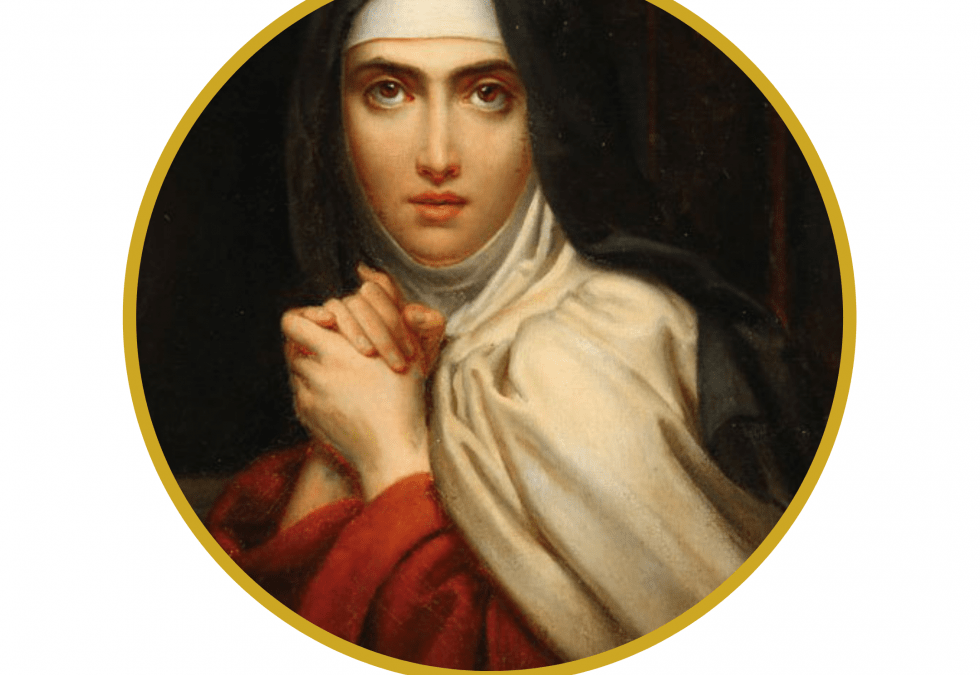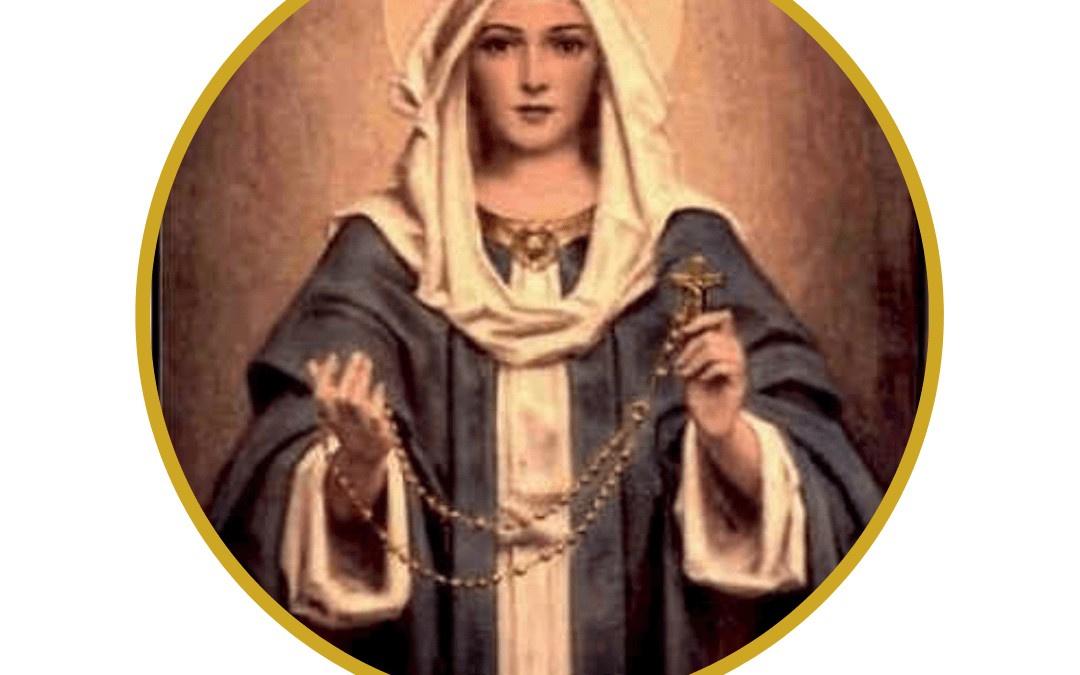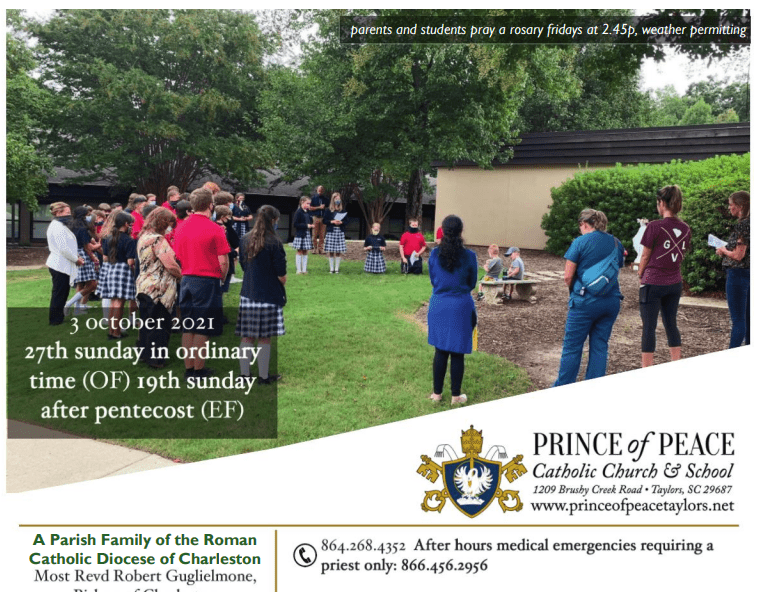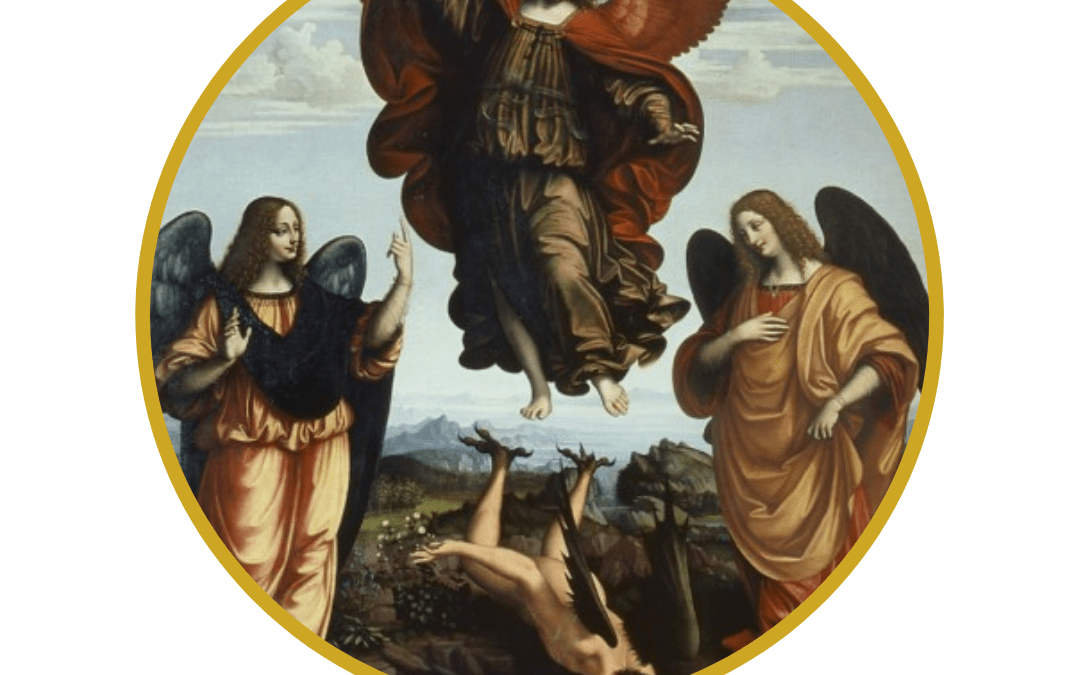
17 October 2021 Bulletin
Click here to read this weekend’s bulletin: 17 October 2021

Click here to read this weekend’s bulletin: 17 October 2021

15 October: Feast of Saint Teresa of Jesus. Also known as St. Teresa of Avila, she was born in the Spanish city of Avila in 1515. Her father was an ardent Catholic, with a collection of spiritual books of the type his daughter would later compose herself. As a child, Teresa felt captivated by the vision of God granted to the saints in heaven. She and her brother once ran away from home for the sake of dying as martyrs in a Muslim country, though a relative found them and promptly sent them back home. When Teresa was 14, her mother died, causing profound grief and prompting Teresa to embrace the Virgin Mary as her spiritual mother. After this, she struggled with a loss of her childhood zeal for God. Her father sent her to be educated in a convent of Augustinian nuns. Illness forced her to leave the convent. But the influence of a devout uncle, along with reading St. Jerome’s writings, convinced Teresa to then join the Carmelite Order at age 20. She again became seriously ill. She had severe pain and physical paralysis for two years, and afterwards remained in a painful debilitated state. For the next 20 years, she was an obedient Carmelite but struggled with physical pain and spiritual dryness. When she was nearly 40, Teresa was dramatically called to contemplative prayer. She experienced profound changes in her soul and received visions from God. During prayer, Teresa heard God speak and often became totally enraptured and even levitated. These graces reached a climax when her heart received a “transverberation” (piercing) – a mystical grace where a saint’s heart is pierced with a “dart of love” by an angel. Teresa played a significant role in the renewal of the Church that followed the Council of Trent. She proposed a return of the Carmelites to their original rule of life, a simple and austere form of monasticism (founded on silence and solitude) believed to date back to the prophet Elijah. Together with Saint John of the Cross, she founded the Order of Discalced Carmelites – “discalced,” meaning barefoot. She went on to found 30 monasteries. In 1582, Teresa’s health failed her for the last time and she died on October 15th. She was canonized in 1622. In 1970, Pope St. Paul VI proclaimed St. Teresa the first woman Doctor of the Church. She is called doctrix mystica, doctor of mystical theology. {Nine months after Teresa died, her body was exhumed and found incorrupt. Later, her heart was removed, enclosed in a crystal vessel and placed in a silver reliquary. While this was being done they beheld a glorious sight: a visible wound from the angel’s dart! It can still be seen today at the Carmelite Monastery of Alba de Tormes in Spain. Miraculously, her heart has kept its color and three sharp thorns in the heart are still visible today.}
“Let nothing affright thee, Nothing dismay thee. All is passing, God ever remains. Patience obtains all. Whoever possesses God Cannot lack anything. God alone suffices.” –St. Teresa of Avila
Ideas for celebrating this feast day at home:

Click to read this week’s bulletin: 10 October 2021

7 October: Feast of Our Lady of the Rosary. Known for centuries as the Feast of “Our Lady of Victory,” this day takes place in honor of a naval victory which secured European Christendom against Turkish invasion in 1571. Pope St. Pius V attributed the victory at Lepanto — one of the most decisive in all of naval history according to historians — to the intercession of the Blessed Virgin Mary through a campaign to pray the Rosary. The Muslim Ottoman Empire had been expanding into Europe for 900 years. By 1453, they took over Christian lands in the Byzantine Empire, and continued into the Mediterranean, threatening Rome. Pope Pius V called for prayer and action. He pleaded with every man, woman, and child to pray the Rosary. He also put together the Holy League: a coalition of Catholic powers which included Genoa, Spain, and the Papal States. Its fleets sailed to confront the Turks near the west coast of Greece on October 7, 1571. They were vastly outnumbered. The Pope, Christians throughout Europe, and crew members armed themselves with the Rosary in preparation for battle. Mass was said on all 200 ships. People prayed from dawn to dusk. Christians in Europe, encouraged by the Pope, gathered to invoke the Virgin Mary against the daunting Turkish forces. They kept churches open day and night so everyone could pray and ask for Mary’s help. The wind was against the Christians and the heavy iron rams (which ordinarily were used to ram and sink enemies) had been removed because over 18,000 Christian slaves were oarsmen in the galleys. The Holy Alliance chose to handicap themselves rather than sacrifice the slaves. As the battle commenced, everyone prayed. Some accounts say that Pope Pius V was granted a miraculous vision of the Holy League’s stunning victory at 4pm that day. The Pope understood the significance of the day’s events, when he was eventually informed that all but 13 of the nearly 300 Turkish ships had been captured or sunk. The victory was decisive and crushing. It marked a turning point in the history of Christianity and of Europe. Pope Pius V dedicated the day as one of thanksgiving to Our Lady of Victory. Pope Gregory XIII later changed the name to the Feast of Our Lady of the Rosary.
“It has always been the habit of Catholics in danger and in troublous times to fly for refuge to Mary. This devotion, so great and so confident, to the august Queen of Heaven, has never shone forth with such brilliancy as when the militant Church of God has seemed to be endangered by the violence of heresy … or by an intolerable moral corruption, or by the attacks of powerful enemies.” – Pope Leo XIII
Ideas for celebrating this feast day at home:

Click to read this week’s bulletin: 3 October 2021
Changes since the bulletin was printed: daily Mass will be at St Rafka Maronite Church at 12n on Tuesday, Wednesday & Thursday. We hope to return to our own Church on Friday, 8 October at 12n for EF Mass. Also, the Children’s Holy Hour has been canceled

29 September: Feast of Saints Michael, Gabriel & Raphael, Archangels. This feast, also known as “Michaelmas,” was a Holy Day of Obligation until the 18th century. The Catechism of the Catholic Church teaches that “The existence of the spiritual, non-corporeal beings that Sacred Scripture usually calls “angels” is a truth of faith. The witness of Scripture is as clear as the unanimity of Tradition.” Archangels are one of the nine choirs of angels listed in the Bible. (In ascending order, the choirs or classes are: Angels, Archangels, Principalities, Powers, Virtues, Dominations, Thrones, Cherubim, and Seraphim.) St. Michael’s name means “Who is like unto God?” and he is known as the Prince of the heavenly host. St. Michael’s task is doing battle against Satan and all his evil followers. His name appears in Scripture four times. He is usually depicted as a mighty warrior and is known as a champion of justice; the guardian of the Church; the protector and defender the friends of God. We invoke St. Michael for help in the fight against evil and to rescue souls from Satan, especially at the hour of death. St. Gabriel’s name means “God is my strength” and he appears as a messenger in the Bible three times (to the prophet Daniel; to Zachariah announcing the birth of John the Baptist; and to Mary at the Annunciation). St. Gabriel’s famous greeting to Mary at the Annunciation was Hail Mary, full of grace. St. Raphael’s name means “God has healed.” Knowledge of St. Raphael comes from the book of Tobit. His mission as healer and fellow traveler with Tobias has caused him to be invoked for journeys and at critical moments in life. Tradition also holds that Raphael is the angel that stirred the waters at the healing pool in Bethesda. Another angelic feast is celebrated this week on 2 October: Feast of the Guardian Angels. “From infancy to death human life is surrounded by their watchful care and protection. Beside each believer stands an angel as protector and shepherd leading him to life.” (Catechism of the Catholic Church, 336) St. Bernard wrote “…the angels are here; they are at your side, they are with you, present on your behalf. They are here to protect you and to serve you.” God has given each of us the incredible gift of a guardian angel – they will protect us and help us attain eternal salvation. “For he will give his angels charge of you to guard you in all your ways.” (Psalm 91:11)
Ideas for celebrating this feast day at home:
Recent Comments